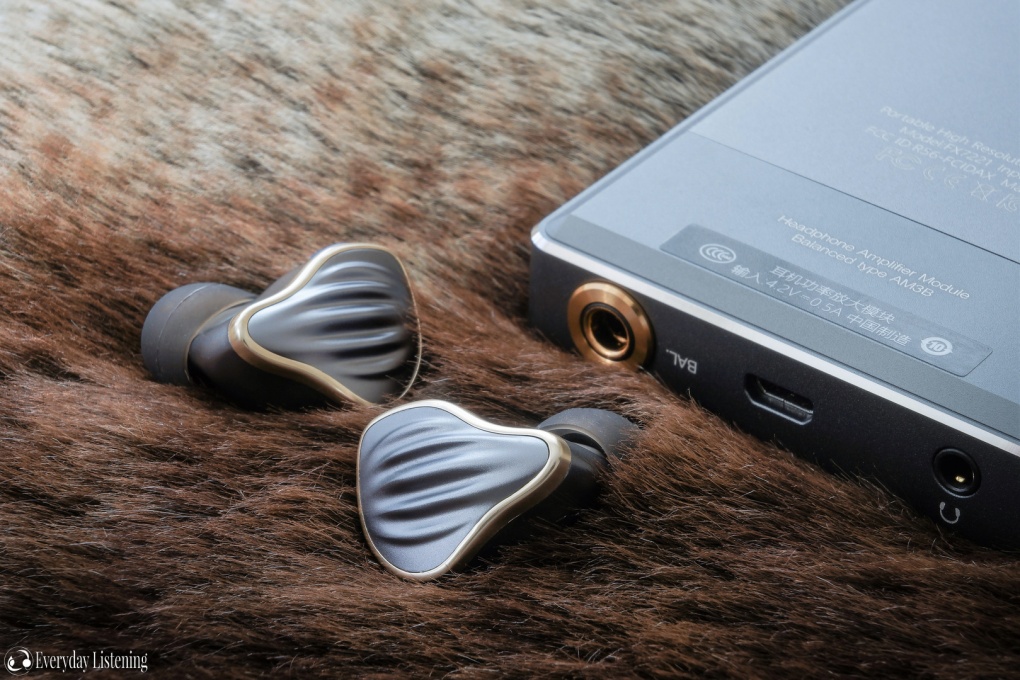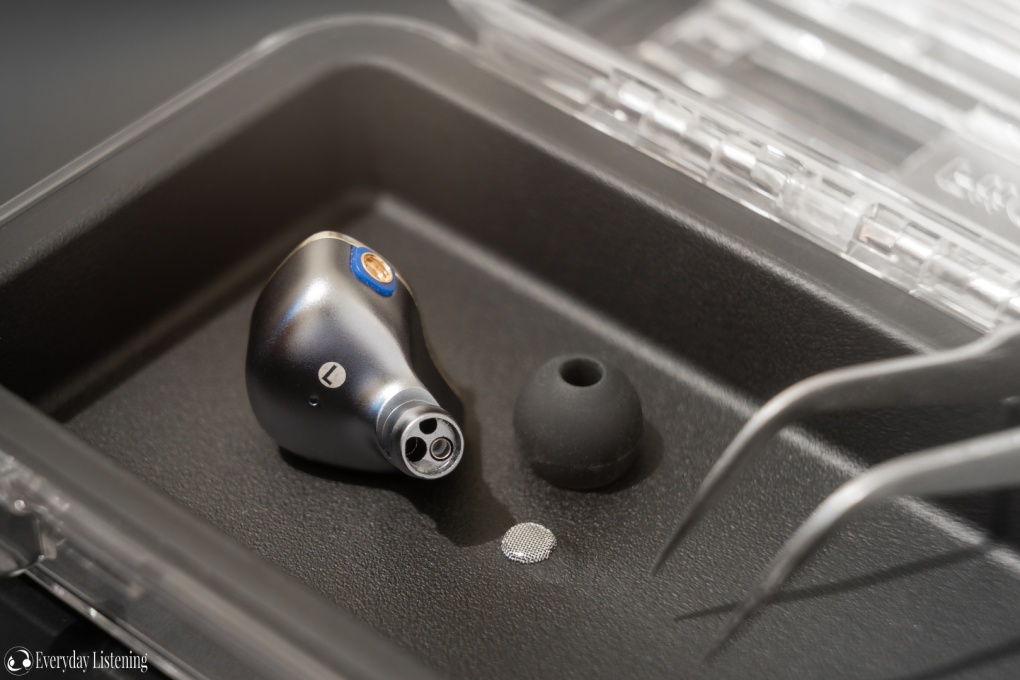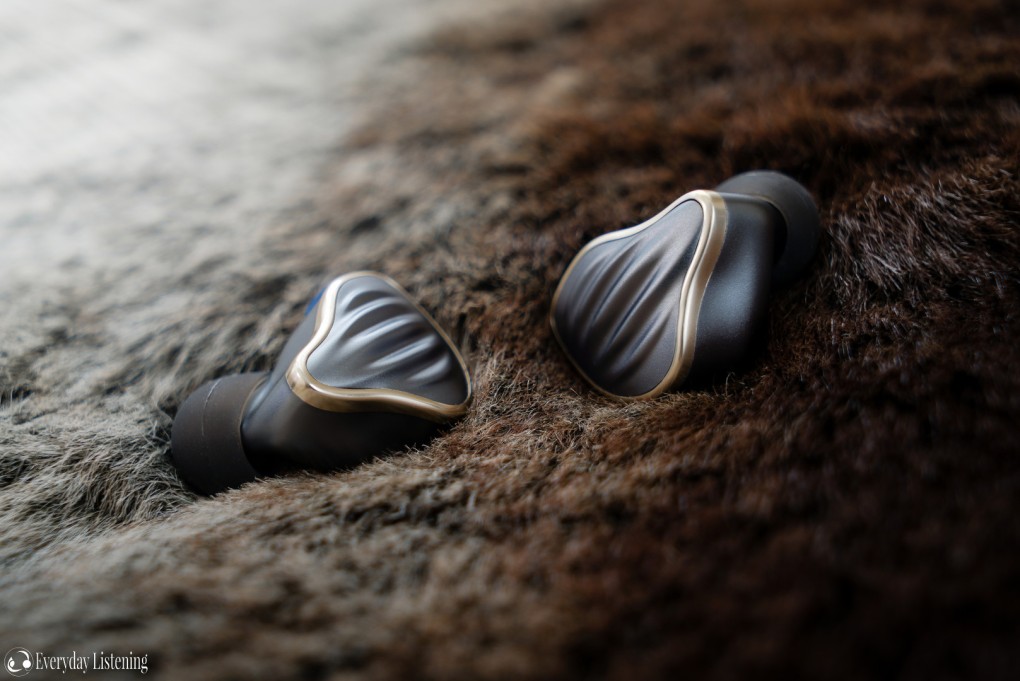Sound –
Tonality –
The FH5 is a W-shaped earphone, forgoing the brighter sound of the F9 earphones and instead adopting the fuller and more bass-focused voicing of the cheaper FH1 before it. What makes the FH5 quite interesting is its combination of a natural, often surprisingly close to neutral tone set to a very smooth, dense midrange. It achieves this not through enhancing the bass or lower-midrange but through sharp attenuation just before the lower-treble combined with a focus on sub over mid-bass; so its tone is not especially warm. A notable centre midrange bump redeems vocal presence in the face of its slightly more energetic lower-treble and voluminous sub-bass thereby producing a sound that is very engaging but also relatively balanced overall.
Ear Tips –
The FH5 includes 4 types of ear tips that slightly alter the sound to user taste. The vocal tips offer a slightly brighter sound, delivering greater upper-midrange and lower-treble presence. This bolsters clarity and also detail presence, however, the tips are actually less detailed as treble becomes slightly more brittle. Meanwhile, the bass tips offer quite the opposite effect, offering a darker, warmer sound by attenuating the higher frequencies, chiefly, the upper-midrange. The foam tips also offer a slightly warmer sound, treble is further attenuated and bass becomes a touch soft and congested. They aren’t ideal sonically but do aid isolation and fit so they have a purpose. All sound comments are using the balanced tips that I found to offer the most versatile presentation.
Bass –
Sub-bass drives the FH5’s low-end with fairly large emphasis before sloping gradually downwards into a lightly attenuated lower-midrange. Combined with its stronger extension, the FH5 digs deep, delivering bold rumble and great slam and power. Mid-bass is lightly elevated, creating enlarged yet natural notes without introducing obvious bloat and warmth. On the flipside, upper-bass is quite neutral if not slightly attenuated, preventing over-warming and congestion while aiding bass/midrange separation.
Low-end notes are characterised by their smooth texture, a by-product of the FH5’s slightly slower decay. Notes don’t linger to congestion, however, bass isn’t especially fast. Still, the FH5 represents a clear step up from the more mid-bass focused F9 and FH1, sounding considerably cleaner. The FH5 does demonstrate good control and retrieves plenty of detail considering its fuller tuning. Listeners used to BA earphones may expect greater definition, however, the FH5 is an earphone that ultimately focusses on sub-bass power and a natural tone over speed and micro-detail.
Mids –
The FH5’s midrange is very intriguing and tends to prioritise vocals over instruments. This stems from a recessed lower-midrange that serves to increase tonal transparency set to a steep incline to a 2KHz peak that enhances vocal presence. As bass is full and the earphones have a sharp sub-5KHz attenuation, vocals are dense, smooth and full-bodied. Upper-mids are the most present within the FH5’s sound, producing forward female vocals while male vocals sit a touch behind. Despite bass and treble being tuned to draw attention, vocals never become lost in the mix as a result.
Moreover, as their vocal bump begins a decline into the 3-5KHz range, mids aren’t at all shrill or fatiguing as some upper-midrange forward earphones tend to be. The result is a nicely natural and simply pleasant midrange presentation with great density that nonetheless upholds a high level of vocal presence and clarity. As they are quite sculpted, I can’t say timbre is especially accurate and upper-mids occasionally sound truncated, lacking some extension. However, this is undeniably a presentation many will enjoy.
Highs –
With their sharp 5KHz dip followed by an energetic 6KHz region, I was not expecting the FH5 to sound as natural as it does. Its lower-treble doesn’t particularly stand out as upper-mids are similarly quite forward. However, lower-treble does maintain a slight emphasis that aids attack and detail presentation. The enables a pleasantly crisp presentation without sounding thin, raspy or over-articulated. Higher up, middle-treble has just enough presence to imbue air and enable cymbals to shimmer and decay naturally without erring into brightness. In fact, I would actually consider the FH5 to have a cleaner background.

This is a refreshing change from the F9 earphones that had a rather outstanding lower-treble peak that would destroy any semblance of natural instrument timbre. Despite not being nearly as bright, the FH5 is easily the more detailed earphone, performing well even within its higher price class. Furthermore, its treble notes are far better resolved as they are more complete. The FH5 has a touch of additional sparkle at the very top that adds a little clarity and energy to their sound. Once again, the treble presentation of the FH5 is very pleasant, well-detailed and plenty clear without a hint of fatigue.
Soundstage –
The FH5 has a moderately expansive soundstage that extends to the periphery of the head and occasionally just beyond. This stems mostly from its forward upper-midrange that tends to push elements forward, thereby reducing perceived space. Unlike most earphones, the FH5 actually has more depth than width but it remains coherent nonetheless. Imaging, in particular, is quite strong with a defined centre image for vocals and clear, concise instrument placement to the sides. Separation is mixed but leaves a positive impression overall as the core frequency ranges remain distinct at all times due to its somewhat W-shaped tuning. On the contrary, as mids are quite full-bodied and similarly, bass notes are quite full, the FH5 doesn’t have the same definition as neutral earphones, however, it does a very nice job within the higher frequencies at reproducing detail-laden tracks without becoming busy or congested.
Drivability –
The FH5 has a low 19-ohm impedance and a higher 112dB sensitivity making it quite efficient. It is easily driven to high volumes by a smartphone yet alone a dedicated source. Despite having a higher driver count, the FH5 also isn’t too affected by output impedance. Using an inline switcher to compare between the Hiby R6 (10-ohm output impedance) and Fiio X7 II (sub-2-ohm), the FH5 sounded only slightly smoother from the Hiby. In particular, upper-mids and lower-treble both sounded slightly smoother and laid-back where the X7 II sounded crisper, clearer and more immediate. Bass was also slightly more controlled on the X7 II, sounding more concise overall. Still, those sensitive to upper-midrange may find it interesting to experiment with impedance adapters to tone down the peak on the FH5. A decent smartphone will, therefore, drive the FH5 quite well, however, it does scale nicely with a dedicated source, gaining detail, clarity and control.
Grill Mod –

This mod involves removing the protective metal grills on the front of the nozzle as suggested by a Youtube Reviewer (source). It’s quite easily done using a pin or some thin tweezers and is reversible if done carefully (be sure not to dent or tear the metal mesh). Indeed, the mod does have some effect and to my ear, it is quite positive. Highs are most affected, specifically I hear more upper-treble presence creating a slightly airier presentation with greater sparkle. Imaging is slightly more holographic and vocals sound a touch more articulate. Surprisingly, bass becomes tighter and more defined. It’s not a night and day difference, but it’s easy to appreciate and effectively livens up the FH5. It’s an easy mod for users to implement.
I did not evaluate the earphone using the mod as it is not the factory spec and some users may feel uncomfortable modifying their belongings. Please note that I do not take any responsibility for voiding your warranty or damaging your IEM, either in removing the grill or due to subsequent damage from debris. Attempt this at your own risk!
Comparisons –
TFZ King Pro ($170): The King Pro is more V-Shaped than the FH5. It shares a well-extended and quite substantially enhanced sub-bass, it also shares a slightly fuller mid-bass. However, the FH5 is more controlled and defined, delivering more bass detail. The FH5 also has the more natural midrange where the King Pro is more upper-midrange biased. As such, it has less body and is less evenly weighted between male and female vocals. The FH5 has a touch less clarity, but it has more body and sounds more natural where the King Pro sounds slightly too forward.
This is also a result of its treble tuning with a prominent middle treble that produces a brighter timbre. However, its lower-treble region is smoother than the FH5 so it also lacks the same crispness and note attack. As a result, the FH5 comes across as more detailed and less brittle sounding, it is cleaner and more composed up top. The King Pro, on behalf of its more laid-back midrange sounds more expansive while the FH5 is more coherent with more precise imaging due to its greater balance.
Campfire Audio Comet ($200): The Comet is more balanced than the FH5, and its midrange is similarly tuned, providing a similar vocal experience. However, its low-end differs with slightly more bias towards the mid and upper-bass, creating a slightly warmer and more organic sound. Still, being a BA, it lacks the same extension and sub-bass power but also has significantly faster decay, being more defined and detailed despite being warmer. Its midrange is slightly more even, especially through the centre midrange, and builds to a gradual upper-midrange peak.
It also shares a 4KHz dip that makes vocals sound smooth and full but also a little truncated on certain tracks. It isn’t to the same degree, however, as its bass is fuller, its midrange is just as full and smooth as the FH5. Up top, the FH5 has more foreground clarity while the Comet having more air (without erring into brightness). Both are clean and similarly well-detailed, the FH5 is a touch crisper in its tuning. The FH5 has a slightly larger soundstage, it is more dynamic but also less precise.
Dunu Falcon-C ($200): The Falcon-C is slightly more V-shaped without the centre midrange push to redeem vocal presence, however, overall, it is much more linear and almost as balanced. Sub-bass extension is almost as good, the Falcon-C has emphasis here but not to the same degree as the FH5, sounding more tonally neutral. Its bass is much faster, slightly more controlled and more defined. Its midrange is more even, lacking the peaks and troughs of the FH5 so it tends to sound more consistent between tracks.
However, in return, it does have more laid-back vocals and doesn’t have the same clarity. Due to its lower-treble emphasis, some over-articulation is also evident without added density to smooth it out. In turn, treble is very crisp and more aggressively detailed than the FH5. It is also thinner and total detail retrieval is a touch higher on the FH5 as instruments have more body and micro-detail. Meanwhile, the Falcon-C has a larger soundstage as it isn’t so forward in its presentation.
Simgot EM3 ($260): The EM3 is less-balanced, delivering a brighter and leaner sound. However, it has similar bass extension and enhanced sub-bass slam that keeps it engaging. It doesn’t have as much bass overall but its low-end is appreciably cleaner, faster and more defined at the cost of fullness and warmth with noticeably less mid and upper-bass. The midrange is more present but has less body and more of an upper-midrange bias. Vocals are clearer and female vocals are more present.
The EM3 has more upper-midrange extension and its treble is more present. However, overall its midrange is less natural. The EM3 has more treble presence, especially middle treble, the source of its brighter timbre. It has more lower-treble crispness as well, but doesn’t overdo the 6KHz region so it isn’t too sibilant or over-articulate while remaining well-detailed and crisp, more so than the FH5. The EM3 has a slightly wider soundstage but more intimate depth and it has easily superior separation but at the cost of being less coherent.
Final E4000 ($270): The E4000 is more traditionally V-shaped than the FH5. It has similar bass extension and emphasis, in fact, it has even greater mid-bass emphasis sounding warmer. That said, its bass is more controlled and appreciably more defined than the FH5 so although bass stands out more, it is of higher quality. The E4000 has a more vocally recessed midrange, but it has simultaneously greater clarity as a result of gradual upper-midrange emphasis in addition to greater extension that prevents truncation.
The FH5 sounds more balanced and smoother where the E4000 is more natural and clearer even though vocals sit further behind. The E4000 and FH5 both have lower-treble dips so they don’t have a lot of crunch of articulation but still maintain fair crispness and clarity up top. The E4000 is thinner than the FH5 and a touch crisper though both are similarly detailed overall. The E4000 has a wider soundstage but less depth and both image very well for their asking price.
Oriveti New Primacy ($300): The New Primacy is more balanced but shares a similar denser midrange darker background. It lacks the same kind of bass extension and slam, and has considerably less bass overall, but its bass is also faster and more defined. The New Primacy has a more forward midrange, especially vocals. It also sounds very smooth and slightly full-bodied but also not quite as full and warm as the FH5 as it lacks the same bass presence. In return, it has greater midrange definition and clarity with greater separation despite lacking outstanding upper-midrange emphasis.
Meanwhile, the New Primacy has a small lower-treble peak that enhances detail presence. The FH5 sounds a touch smoother and fuller here, both are similarly well detailed even though the New Primacy sounds crisper. Both extend well up top, the New Primacy extends further and has a slightly larger stage with more distinct foreground/background separation on account of its darker background. Meanwhile, the FH5 has more air and energy throughout its presentation which is more engaging.
Cardas A8 30th Ann. ($300/350): The A8 is more of an L-shaped sound, sounding darker and more bass-focussed. It has similarly strong sub-bass extension but as it has equal focus on sub and mid-bass, it sounds a touch warmer and fuller. The A8 has slightly more control sounding a touch more defined despite being fuller while the FH5 has a smoother bass texture. The A8 has a darker midrange with distinctly less clarity and vocal presence. However, as its upper-midrange has a nudge of emphasis, it doesn’t sound veiled or closed-in. Still, the FH5 has greater vocal presence and clarity, it sounds more natural through the midrange. The A8 has a touch of additional lower-treble to imbue detail presence, however, the FH5 sounds more detailed and extended. That said, the A8 has a substantially larger soundstage in all dimensions, providing an immersive listen.
Verdict –
The F series earphones turned over a new leaf for Fiio as a bonafide IEM manufacturer and the new FH earphones represent an evolution, not only in design but intention. These are markedly more mature products with significantly more palatable sound tuning and design. The FH5 is the first Fiio earphone that I personally feel to genuinely excel at its price point rather than just matching expectations. It’s too easy to diminish expectations with a price tag lower than what we have come to expect in recent years of constant inflation, however, such a mindset alienates the average consumer who may not have so much to spend.

What we’re left with is a well-priced all-rounder; an IEM with a balanced yet engaging tuning that finds a happy medium between the high-clarity sound of Asia and the warmer tones of the West. The FH5’s wonky midrange isn’t perfectly voiced for every track and its bass isn’t the most defined, those wanting hyper-clarity and separation also won’t find it here. What the FH5 instead provides is a rare W-shaped signature more frequently carried by more expensive models realised through impressive technicals at a reasonable price, and users are able to slightly increase the quality of the FH5’s sound through a simple mod.
The Fiio FH5 is available from Amazon (International) for $259 USD at the time of writing. Please see my affiliate link for the most updated pricing, availability and configurations.




3 Responses
If a dented one of the mesh is it REALLY bad or nah. Thank you and great review!
Hello! Can you compare it with F9 Pro? As i have F9 Pro and X7II but is it worth for FH5?
Any comparison with the iBasso IT01? would the FH5 be an upgrade or a side step?
Q. The Final E4000 cust only $140 where the Final E5000 is costing around $270. Are the price and type numbering oké? or was a typo made?